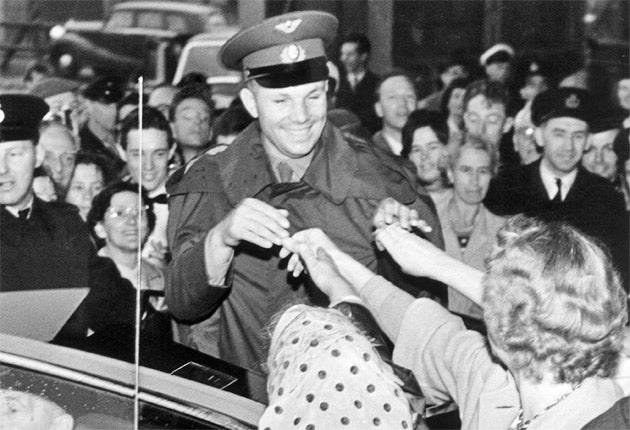Statue of first man in space gets lift-off in London, 50 years late

As the first man to rocket into space on 12 April 1961, Yuri Gagarin was fêted in his homeland as a hero of the Cold War. Then, just three months after his historic mission, he made the much shorter – and less prestigious – flight to Manchester as the guest of the British Foundry Workers' Union.
Now, 50 years later, Gagarin's unlikely visit, which became a tour and included lunch with the Queen, is to be commemorated with a statue on London's Mall.
The monument, the first of a Soviet-era Russian in the capital, will sit opposite Captain Cook's statue near Admiralty Arch. It will be a copy of an already-existing statue in Lyubertsy, on the outskirts of Moscow, where Gagarin trained to be a foundry work at a steel plant, before beginning his training for space travel.
The British Council, working with Russian space agency, Roscosmos, has coordinated the placement of the statue, which is part of YuriGagarin50, a year-long celebration of Gagarin's historic flight as well as British and Russian achievements in space flight. The official unveiling of the statue is set to take place in July, to coincide with the 50th anniversary of Gagarin's British tour.
Gagarin arrived in London on the morning of 11 July 1961. He made a visit to the Russian Embassy before flying to Manchester the following day, where he met representatives of the Amalgamated Union of Foundry Workers. The organisation's president gave Gagarin a gold medal, before the cosmonaut went on to meet Prime Minister Harold Macmillan in London, and had lunch with the Queen and Prince Philip. He also attended a reception at the Society for Cultural Relations between the British Commonwealth and the USSR, now renamed the Society for Co-operation in Russian and Soviet Studies (SCRSS), in Kensington.
"The British government had to play catch-up back then because Gagarin wasn't officially invited by them," said SCRSS vice-chair Ralph Gibson. "By July he had become the first international superstar. He wasn't a film star or a politician. You see that thousands of people greeted him quite spontaneously. As far as I am aware his British visit was his first to a Western country. At the height of the Cold War it was extraordinary for him to be greeted in the way he was."
According to reports in Russian media, the statue will be copied by Russian sculptor Pavel Medvedev, who has 30 years of experience of specialising in small sculptures.
He said working on the Gagarin statue wasn't easy. "We had to make an exact copy; as a sculptor, if you're doing a copy you want to leave the fingerprints of the initial sculptor," he said. The Lyubertsy monument, which is about 30 years old, was scanned using special equipment, to make a 3D model, then a cast of the monument was made, which served as the base for the new mould.
"Many moulds were made which were then collated in to one," said the head metal specialist of the project, Igor Gorbunov. "A cast was made which we then poured liquid metal into." Those involved employed an aluminum/silicone alloy.
Subscribe to Independent Premium to bookmark this article
Want to bookmark your favourite articles and stories to read or reference later? Start your Independent Premium subscription today.

Join our commenting forum
Join thought-provoking conversations, follow other Independent readers and see their replies